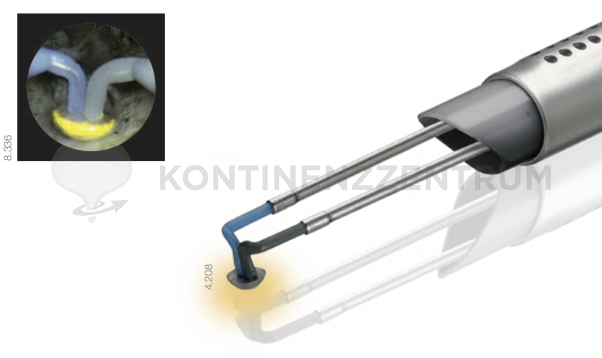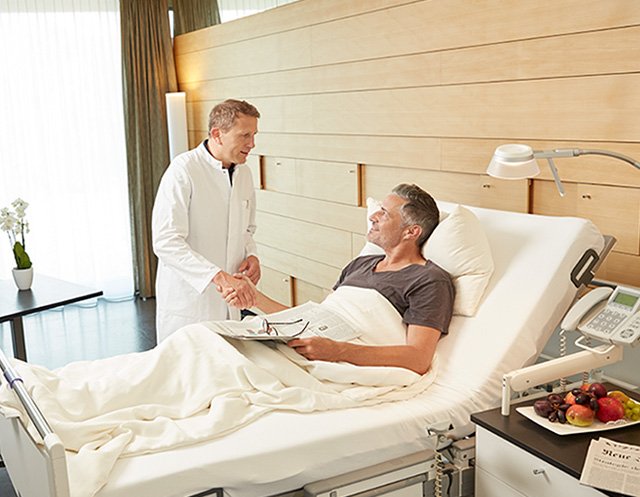TURP: TRANSURETHRAL RESECTION OF THE PROSTATE
Surgical Removal of Prostate Tissue Through the Urethra

In benign prostate enlargement (benign prostatic hyperplasia), the outflow from the bladder is constricted, making it difficult to empty the bladder. Affected men suffer from the typical symptoms of benign prostate enlargement. If the medication available for benign prostate enlargement is not sufficiently effective or is not tolerated well by the body, prostate tissue can be surgically removed using the TURP procedure.
TURP or TUR-P stands for "transurethral prostate resection" and is also known as bipolar resection of the prostate. The procedure is performed transurethrally, i.e. through the urethra. TUR-P is currently the standard surgical procedure for treating a benignly enlarged prostate.
TURP: Procedure of the Operation
TURP prostate surgery can be performed under general anesthesia or spinal anesthesia. During the procedure, an optical instrument (resectoscope) and an electric snare are inserted via the urethra. The snare is used to remove the enlarged tissue inside the prostate and reopen the drainage pathway from the bladder. Bleeding from opened vessels is stopped with an electric current. After the procedure, a permanent catheter with an irrigation fluid is inserted to flush the bladder and left in place for a few days. Once the catheter has been removed, the bladder can once more be emptied without interruption and with a good flow of urine.
Prostate Enlargement? Learn More About the TURP Method
Transurethral resection of the prostate (TURP) is the standard surgical treatment for benign prostate enlargement. Consult our experts now and find out how this procedure can help you.
Advantages of the TURP Method
- Has been the proven standard method for the treatment of benign prostatic hyperplasia for many years
- Gentle access to the prostate and bladder via the urethra
- No skin incisions necessary, therefore no visible scars after the operation
- Ability to empty the bladder is restored without restrictions a few days after the procedure
- Under certain circumstances, the operation can be performed to preserve ejaculation (ejaculation-protective transurethral resection of the prostate), so that the ability to ejaculate is also preserved
Possible Risks and Complications of Bipolar Prostate Resection
As with any surgical procedure, TUR-P also carries a low risk of rare complications. However, the potential risks are highly individual. The TUR-P procedure has been tried and tested for decades and is performed as a standard procedure. If and what risks are to be expected in your individual case will be explained by the attending physician in a detailed consultation if the TUR-P procedure is being considered for treatment.
Aftercare Following Prostate Surgery using TURP
 Patients usually stay in hospital for three to four days after the procedure. During this time, the bladder is emptied using a catheter. This is removed before the patient is discharged from hospital. In the first few days after removal of the catheter, it is important to drink plenty of fluids to flush the bladder and speed up the healing of the wound. Patients should avoid strenuous physical activity such as cycling, motorcycling or lifting heavy loads for the first few weeks. Sexual intercourse, hot baths, saunas and heat applications should also be avoided in the first few weeks after the operation. Showering is permitted. Please make sure you have soft bowel movements to avoid postoperative bleeding. Our specialists will be happy to explain to you how you can contribute to this with your diet.
Patients usually stay in hospital for three to four days after the procedure. During this time, the bladder is emptied using a catheter. This is removed before the patient is discharged from hospital. In the first few days after removal of the catheter, it is important to drink plenty of fluids to flush the bladder and speed up the healing of the wound. Patients should avoid strenuous physical activity such as cycling, motorcycling or lifting heavy loads for the first few weeks. Sexual intercourse, hot baths, saunas and heat applications should also be avoided in the first few weeks after the operation. Showering is permitted. Please make sure you have soft bowel movements to avoid postoperative bleeding. Our specialists will be happy to explain to you how you can contribute to this with your diet.
In order to regain control over urination quickly and permanently, targeted pelvic floor training or training of the urethral sphincter can be useful. Patients receive appropriate recommendations from their attending physician at the KontinenzZentrum Hirslanden in Zurich.
For a speedy recovery, it is essential that patients are conscientious about their aftercare and attend the follow-up appointments scheduled by their doctor. If you experience any health complaints or a fever of over 38 degrees immediately or a few days after the TUR-P operation, inform your doctor immediately.
Important Information Regarding Cancer Prevention
When treating a benign enlarged prostate using the TURP method, only the inner glandular tissue is removed. The outer layer of tissue is preserved. This means that the risk of cancer remains. Patients should therefore continue to undergo regular cancer screening by a urologist.
Alternative Surgical Procedures in Addition to Transurethral Resection of the Prostate
The surgical treatment of benign prostatic hyperplasia depends primarily on the degree of enlargement. The TURP procedure is well suited for a slightly to moderately enlarged prostate. If the prostate is already severely enlarged, transurethral resection reaches its technical limits. In this case, other surgical procedures such as bipolar enucleation (vaporization) and the modern Da Vinci method can be used to treat prostate enlargement.
The robot-assisted Da Vinci method is a safe and sustainable prostate operation for very large prostates. The procedure is performed using laparoscopy and therefore requires very few, small incisions. This gentle approach to the bladder and prostate has several advantages for the patient, such as less blood loss, less pain after the operation, smaller scars and a shorter stay in hospital.
Which surgical procedure is used to remove the enlarged tissue depends not only on the degree of prostate enlargement but also on other individual factors. In a detailed consultation, the doctor informs the patient in advance about applicable procedures, the prospects of success and advantages as well as possible risks.
Find out more about the TURP Method (Transurethral Resection of the Prostate)
Contact us for a consultation! We will be happy to inform you about your individual assessment and treatment options as well as about TURP (transurethral prostate resection) and other prostate surgery procedures. You can reach our center (KontinenzZentrum Hirslanden) in Zurich by telephone. Our clinic is open from Monday to Friday between 8 am and 5 pm. You can also make an appointment online!
